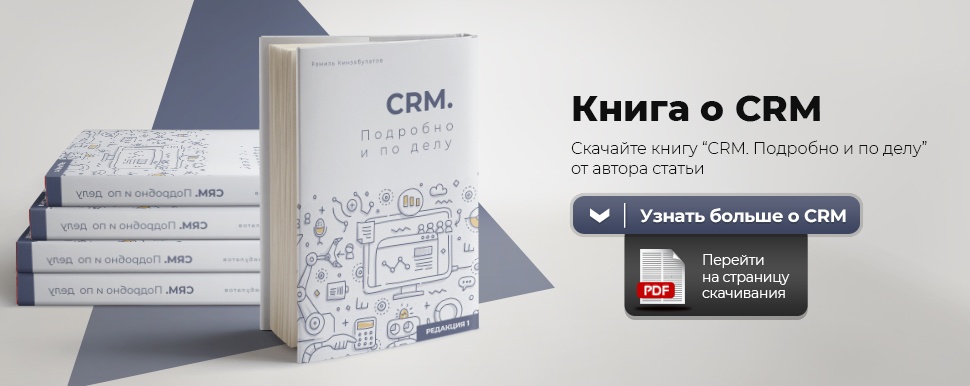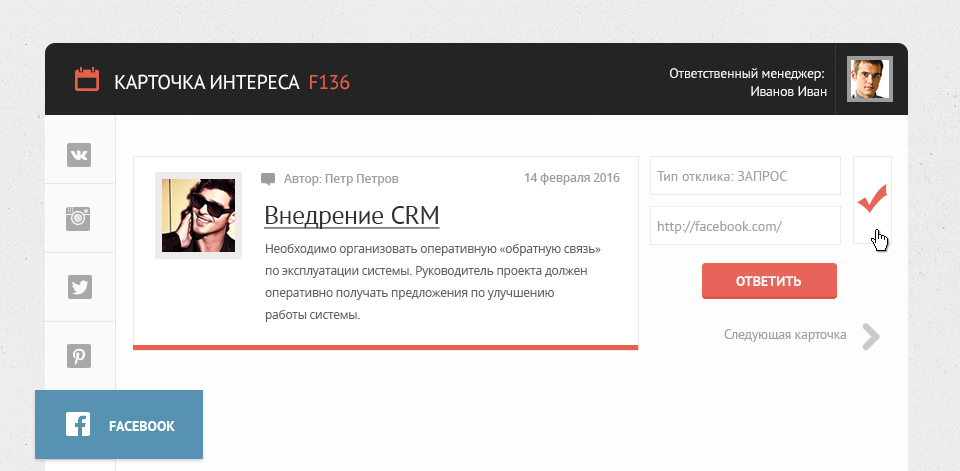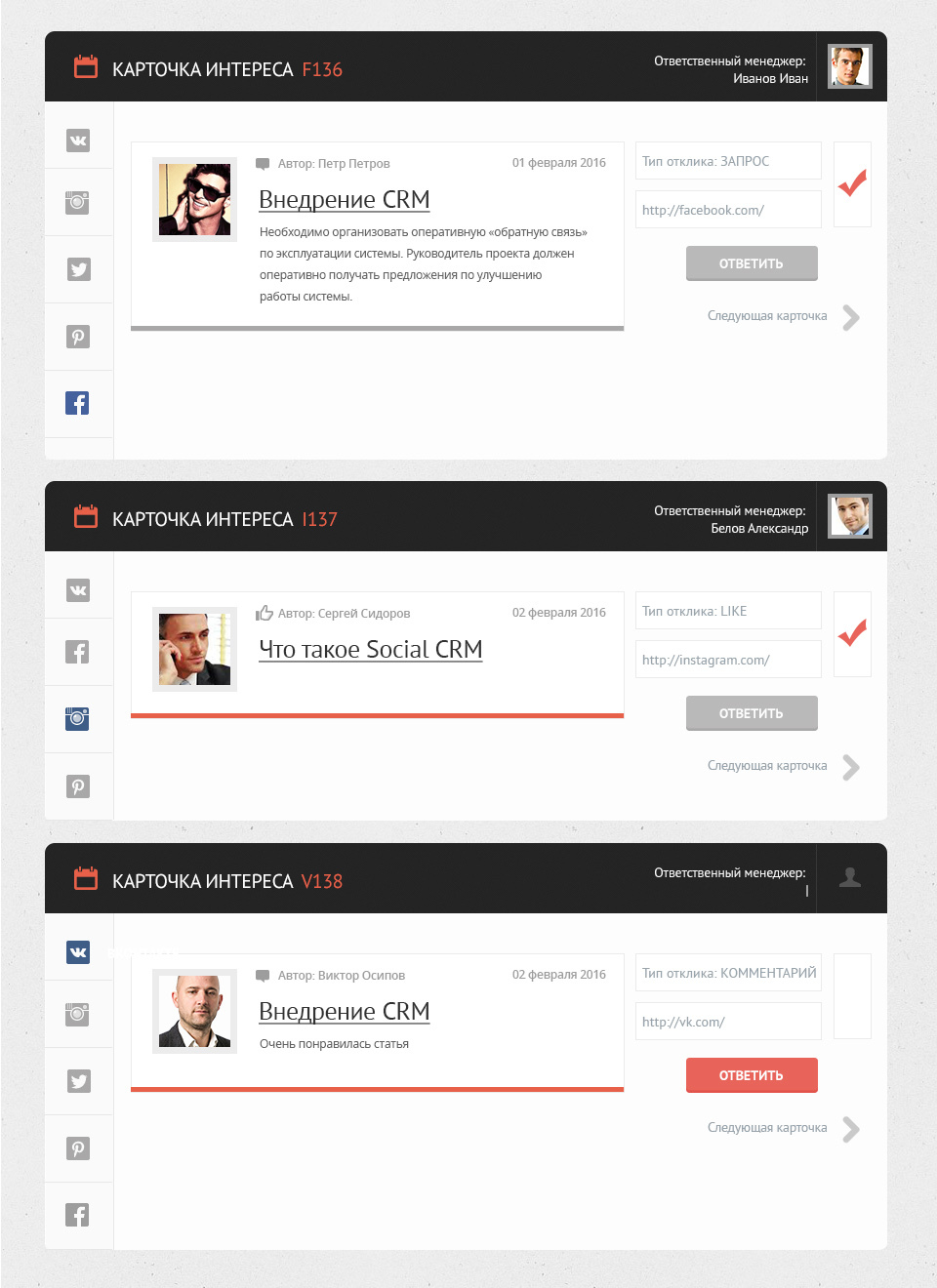Social CRM. Gathering the interest of Internet users
 With this article I open a cycle - a description of the work of Social CRM, i.e. software products aimed at working with the interest of users in social networks. Like other CRMs, these products will help increase the effectiveness of the sales and marketing departments, will allow for clear control of the quality of staff work, and will also increase the level of automation of staff work.
With this article I open a cycle - a description of the work of Social CRM, i.e. software products aimed at working with the interest of users in social networks. Like other CRMs, these products will help increase the effectiveness of the sales and marketing departments, will allow for clear control of the quality of staff work, and will also increase the level of automation of staff work.I have been implementing CRM systems for quite some time, and in almost every project the task arises of collecting the interest of potential customers in the company, in its products or services. Now almost every company has some kind of pages on social networks, feedback forms, comments, discussions on the site, etc. And the question arises, how to collect all this data if the company has several sites, for example, a website, a VKontakte group, on Facebook, and several managers work with clients.
Today the first software products called Social CRM have already appeared, i.e. CRM systems designed to work with social networks and with user activity in them. Most of them are English-speaking, and the automation of work in them is mainly aimed at working with Facebook and Twitter. On the other hand, it’s quite possible to work with the interest of users within the framework of the CRM system that you use to work with leads and customers. Therefore, it is possible to start automation and collection of interests of users of social networks at any time with minimal cost.
What is user interest, and how is it manifested?
The active work of commercial companies in social networks has led to the need for new concepts and new tools. And today it’s not enough to take into account and analyze only leads, i.e. requests from potential customers received through the site or from another source, for example, by phone. The success of work in social networks is determined by the interest of users.
The interest of users is any action, which may include likes, reposts, comments, requests, and site transitions that demonstrate the interest of users in your product or service.
Even if the user of social networks is not your future buyer, the interest shown in your company can serve to increase the level of customer confidence and / or provide access to information to your company and its products / services to a wider audience. On the other hand, publicly expressed negativity from users or questions that remain unanswered will reduce the level of trust, which may also negatively affect the level of sales and profits of the company.
Working with user interest is significantly different from working with orders and requests, a larger number of user actions suggest a wider range of reactions of company employees. In principle, working with social networks is a large, separate and very important segment for any business, which is closer to working with the public than with potential customers (leads). And, nevertheless, it also needs to be automated, analyzed and improved.
Why is it important to collect this data?
Firstly, any activity, even if it’s just like or a comment from the “I liked your product” series, and even more questions about the product, as well as how and where to buy it, can be considered as a potential deal, as an interest from a potential buyer to a product. And it is very important not to miss a possible deal and any manifestations of this interest.
 In addition, each such manifestation of the activity of potential customers is the result of efforts, and, therefore, costs of the company. Therefore, accounting for activity is important not only to increase sales, but also to increase efficiency.
In addition, each such manifestation of the activity of potential customers is the result of efforts, and, therefore, costs of the company. Therefore, accounting for activity is important not only to increase sales, but also to increase efficiency.Maintaining a group, site performance, search engine promotion - all this requires effort, time and, of course, company funds. Therefore, it is also important to see the result of these efforts in order to increase their effectiveness in the future without increasing the company's costs.
So, on the one hand, any activity is a potential deal, on the other hand, user behavior statistics can improve the efficiency of customer acquisition and even, in some cases, reduce costs.
Why am I focusing so much on the second aspect? The fact is that many companies collect data only from the contact forms of the site, but at the same time, activity on social networks is passed by. As a result, the picture of work statistics in different directions is distorted.
For example, if a person saw information about a product on a social network, wrote a comment, did not wait for an answer, and went to the site, where he filled out the feedback form, in this case he would be counted among the people who became customers thanks to the site. This will be a distortion of real information, and the company will focus on working with the site, instead of activating on social networks, where, in fact, even more buyers can come from.
Thus, collecting statistics from different sources allows you to get the most complete information and, as a result, a realistic picture of work efficiency and costs aimed at different options for attracting customers. Naturally, for any company this is very important.
What does user activity consist of?
It is important to understand what user activity is significant for your company. I divide user activity information into the following parts:
- User activity on social networks. This can be a Vkontakte group, a Facebook page, Twitter posts or Odnoklassniki. It all depends on your choice of social networks. At certain stages, you can also analyze them separately from each other to determine the most effective sources of buyers for your business. And when the work is already on the flow, they can be considered the total number.
- Users who filled out a callback or feedback form on the site. This activity is most often the most interesting, since only people who place an order in the online store are closer to buying.
- Comments on the reviews page or on the product pages. This activity often comes from customers who have already taken place, but here, too, there are requests from people who are in the process of choosing a product, it is also important to monitor them. And the feedback on the purchase made is your face on the Internet, it is very important that there are no unanswered requests or any conflict situations.
- Requests that come to the company's mailbox. Buyers are also often found here, and many of them are large. Representatives of legal entities often write to the mail.
- Various online chats, where potential customers also often ask questions, and working with them is no less important than with telephone requests.
Each of these points should be monitored and worked out by managers and other employees, for example, consultants or group administrators in social networks. In addition, each significant contact should be transferred to the manager for further processing.
In what form should this data be?
Some CRM systems incorporate tools for working with social networks, but these are isolated cases, and the tools themselves, most often, are not very well implemented. In this case, data from different sources are sorted and distributed separately from each other. Requests via web forms from the site are summarized in one place, comments on social networks (I personally only saw integration with Facebook) in another, phone calls in the third, etc.
And I would like for there to be a certain summary report of the activity of potential customers on the Internet, where one could see both their total number and compare different types. It is quite possible to implement it in almost any CRM-system, even on their own.
How to implement this in CRM?
In order to get information about leads (shown interest) from different sources in a single consolidated form, you need to carry out some technical work.
So, first of all, create an Interest card, which forms a table consisting of 10 fields:
- Source - a link to the site where the person came from, or a link to a page on a social network, mail, etc.
- Date - when it happened.
- Type of source - a specific social network, site, etc.
- Author (better with a photo, if not, at least his name).
- Type of action (like, comment, review, request, etc.).
- Text (the text that the client wrote).
- Product (which product was shown interest). Link to the product (program, license, another product - link to the page).
- Responsible. (who will be responsible for working with this lead)
- Processed (tick - yes / no).
- Reply button. It can be - reply with a letter, comment, call, etc.
Interest card example:

Each such card is filled out on the basis of the interest shown. If it is a social network, then a notification of interest usually comes by email, if it is a site, alerts can be implemented by email and / or phone and so on.
In order to automate the process, we collect a maximum of notifications by one email, after which this mailbox must be regularly parsed and automatically transferred to the CRM-system to create cards “Potential Interest”.
Immediately I want to clarify why here the collection of information from the mailbox was chosen, and not already so loved by most APIs. You can, of course, connect notifications from the same Facebook via the API, if you wish, but with the mail to start much faster and more transparent to users.
In addition, a single mailbox can be used for different types of interest - it will be Facebook, Vkontakte, and other social networks, and notifications from the site about comments or requests, and direct letters from users. In general, mail allows you to bring different types of requests together, and use the mailbox as a kind of external repository of "interests from users".
So, the request comes. What happens next? Based on the result of the mail collection, an interest card is automatically created, the source, link to the source, name and photo of the author, date of receipt of the request, type of action, text are also filled automatically. If possible, the product is automatically filled in (if the groups on social networks allow it or if the request came from a specific page on the site).
The person in charge is not automatically filled. There are two ways to resolve the issue:
- Technology "ASAP", I also call it "who managed, he ate." Here, the tape of new interests is available to all managers, and whoever first showed interest in this request will be responsible.
- A strategy based on the distribution of responsibilities without manager activity. For example, in the order of the queue or as the manager is busy.
The “Processed” checkbox is most often put by the manager himself after this interest has been worked out, while the response report in the form of a screenshot is attached to the checkmark. Why do I need a screenshot? For quick quality control of the response by the leader directly in the CRM system ribbon, as well as for the manager himself, so that if he continues to work with this client, he can quickly refresh the beginning of communication in his memory. The screenshot itself can be implemented in any system. It can be a Jing, Joxi system, a link to Dropbox with this screenshot and so on.
The flag “processed” may also be set automatically. Here the logic is as follows: if, when saving the card, the system detects a screenshot of the manager’s response, then the “processed” checkbox is set automatically.
The “Reply” button works as follows. A person should be able to quickly respond directly from the CRM system to the user. So, if this is a response to a comment on a social network, the “Reply” button sends the manager to a page with a comment for a quick reply, if this letter is a transition to the mailbox on the response form, etc.
All this should be in the table and highlighted in color, i.e. if the answer has already taken place, then the button should become gray and inactive.
Interest card example:

What's next?
After the implementation of such tables, work with interest from users will be put on stream and can be controlled in the same way as any leads in the CRM system. Comments will receive timely responses, requests will be processed, and the manager will be able to track the quality of the work of managers with the interest of users in various sources on the Internet.
Also, based on these cards, it will be possible to create various reports that allow you to analyze the effectiveness of certain actions aimed at promoting a brand, recognizing a company and increasing the number of sales via the Internet, and determine the further strategy and those resources that will need to be paid special attention.
The technical implementation of collecting the activity of Internet users in the CRM system is relatively simple and can be implemented for almost any system known today. Of course, it will require the help of a programmer, but such a refinement will take a little time, and increasing the efficiency of the sales and marketing departments after the introduction of such a tool will quickly pay back all investments.

